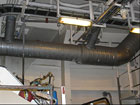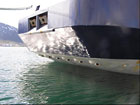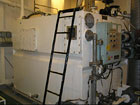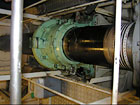

 | ||||||||||||||||||||||
|
|
Journals 2007/2008Kathy Couchon
June 4, 2007 Latitude/Longitude: 81°18.0' N, 011°43.0' E The day dawned on a very different weather scene than yesterday; the brilliant sunshine disappeared late yesterday and today we awakened to the usual fog. My day's game plan was to focus on getting my journals and notes up to date and to prepare for teleconferences with my students at Narragansett High School. Communication back home is a challenge from the Arctic. The Oden is equipped with a state-of-the-art communication system, but because we are so far north and distant from land, it is dependent on satellite transmissions which can be quite costly. We have been asked to limit our e-mails in number and in size. All photos must be resized before being sent so as to limit the amount of transmission time. All participants may post e-mails at any time during the day, but they are sequestered in the system and then sent out en masse twice a day by the IT Technician, Axel Meiton. Axel is the one who will help me set up my teleconferences. He has informed me that I may use Oden's satellite phone. As an alternate choice I could use the phone I have been provided by VECO Polar Resources, a company that provides logistics support for the National Science Foundation in the arctic regions. In anticipation of the teleconference, I have been sending a selection of labeled photos, a few at a time, to my school and the students will view these as a slideshow while the scientists explain them via satellite phone. Time is a variable we must constantly be aware of. We are six hours ahead of my students in Narragansett who attend school on a block schedule, so I constantly check my watch and notes as I try to coordinate the time for the scientists. I am also aware that the scientists' time is valuable and limited as we have only 2 more days of testing before we must head back to port. I do not want to keep them away from their tasks too long. Hanu Singh, co-chief of the test expedition has graciously agreed to speak to one of my classes, as has Tim Shank, chief biologist. I hope my students realize how fortunate they are to be able to speak to world-renown scientists, and from the Arctic, no less. While I am worked on my own logistics, Oden was on the move back to the baseline location we had been working from. The ship had drifted over a short time period and ice had closed in the lead. Keeping a large pool open for operations has been a constant challenge. The science excitement today was about sediments and water samples from a 1360 m depth. Elisabeth, the microbiologist, fixed the sediments to preserve them and my colleague, Deitmar, and I made plans to meet with her later to take a look at what came up. As a final note, I realized that with the excitement of the ice-melting operations yesterday, I did not report what occurred later that evening. Last night I was fortunate to be part of a tour of Oden's lower decks - the engine rooms. Martin Hahne, the ship's second engineer, conducted the tour for a varied group of participants - scientists, grad students, educators. We were able to view many of the unique aspects of icebreaker Oden. Some highlights we viewed:
As if the science itself is not interesting enough, we were amazed by the engineering logistics that enable us to live and work in this environment.
|
|||||||||||||||||||||



